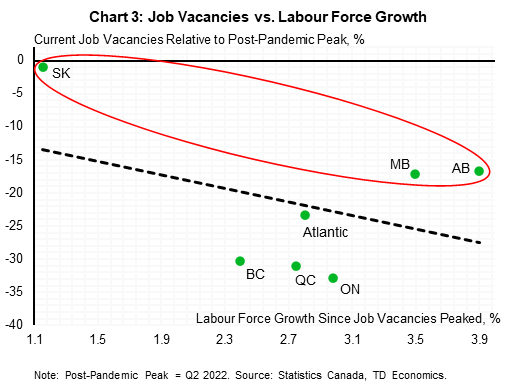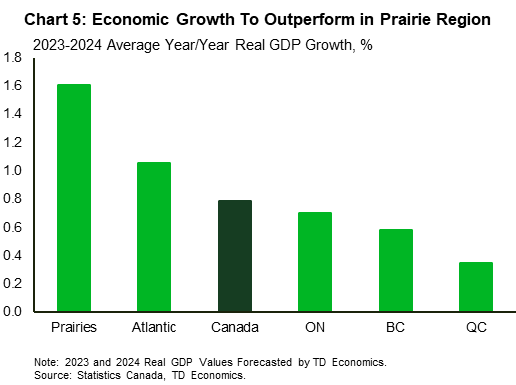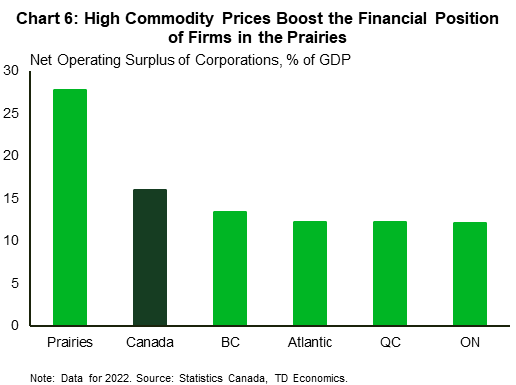
Alexander Suhorucov
“Although shifts in immigration and interprovincial migration can explain why labour markets have loosened across the country, still high commodity prices have boosted economic growth in the Prairies, causing its job market to remain tight,” said the report.
“Given our favourable outlook for oil and other commodities in 2024, regional outperformance in the Prairies should continue, keeping their labour markets tighter than the rest of Canada.”
Here’s the full TD report
 Canada’s labour market has experienced a growing provincial divide. While the job market has cooled from its peak at the national level, the degree of progress made in re-establishing labour market equilibrium varies across the provinces. Job markets remain the tightest in the Prairie region, with job vacancy rates in Saskatchewan, Alberta, and Manitoba currently well above their pre-pandemic norms (Chart 1). Tight labour markets are also found in Atlantic Canada, while the demand for labour in Quebec, Ontario, and British Columbia has relatively normalized. In this piece, we will investigate some of the drivers behind this regional disparity.
Canada’s labour market has experienced a growing provincial divide. While the job market has cooled from its peak at the national level, the degree of progress made in re-establishing labour market equilibrium varies across the provinces. Job markets remain the tightest in the Prairie region, with job vacancy rates in Saskatchewan, Alberta, and Manitoba currently well above their pre-pandemic norms (Chart 1). Tight labour markets are also found in Atlantic Canada, while the demand for labour in Quebec, Ontario, and British Columbia has relatively normalized. In this piece, we will investigate some of the drivers behind this regional disparity.
It’s Labour Supply
Strong labour force growth has been a key factor allowing all provinces to make significant headway in re-balancing their job markets. More available workers within a province offer firms a larger pool of candidates to draw from when seeking to fill their vacant positions. Over the last year, Canada’s population has grown by approximately 1.25 million, with the majority of new Canadians residing in Alberta, Ontario, and British Columbia (Chart 2). At the same time, there has been significant interprovincial migration into Alberta and Atlantic Canada, with outflows coming from Ontario, Manitoba, and British Columbia.


In Chart 3, we show how the provincial drop in job vacancies from their 2022 peak is tied to labour force growth. While increases in the number of workers can explain the falling level of job vacancies in Ontario, Quebec, British Columbia, and Atlantic Canada, three provinces have been outliers. Saskatchewan, Manitoba, and Alberta have not seen job vacancies decline as much as would be explained by increases in labour supply. This implies that demand-side factors may also be contributing to the persistence of elevated job vacancies in the Prairie region.
And It’s Labour Demand
 What’s special about the Prairies when it comes to still robust labour demand? To answer this, we first look at industries with the highest number of job openings. We find that Construction, Healthcare, Accommodation & Food Service, and Retail Trade are the sectors that have the highest job vacancies in the Prairies (Chart 4). Interestingly, these are also the top hiring sectors in every province across the country. So, it is not just that firms in the Prairies are seeking a different labour force skillset compared to other provinces, but the magnitude of employer demand is simply greater.
What’s special about the Prairies when it comes to still robust labour demand? To answer this, we first look at industries with the highest number of job openings. We find that Construction, Healthcare, Accommodation & Food Service, and Retail Trade are the sectors that have the highest job vacancies in the Prairies (Chart 4). Interestingly, these are also the top hiring sectors in every province across the country. So, it is not just that firms in the Prairies are seeking a different labour force skillset compared to other provinces, but the magnitude of employer demand is simply greater.
We believe that strong employer demand in the Prairies is tied to the region’s economic growth outperformance. Real GDP growth in the Prairie provinces clocked in at 5% for 2022 and it is currently tracking at close to 2% for 2023. This compares to just over 3% and less than 1% for the rest of Canada over the same period. Although the Prairie region will not be immune to an economic slowdown, we expect another year of economic outperformance relative to the nation in 2024 (Chart 5).
The Prairie region’s outperformance is driven by the relative size of its commodity-producing industries. In recent years, prices for commodities central to economic activity in the Prairies have increased notably due to various market-distorting events: the surge in wheat/oil prices following Russia’s invasion of Ukraine, OPEC+’s efforts to limit global oil supply, and conflict in the Middle East. While commodity prices have come off their peaks, they remain elevated. Given that energy and agriculture sectors have an outsized impact on Prairie region output, economic growth in the Prairies stands to gain the most from still robust commodity prices (link). The boost to economic activity from elevated commodity prices is reflected in the balance sheets of Prairie region corporations. The net operating surplus of firms, often used as a proxy for profits, accounts for the largest share of provincial GDP in the region (Chart 6). This robust financial position allows firms in the Prairies to better withstand economic headwinds (high inflation/interest rates) and likely contributes to the sustained high demand for labour in the region.


Bottom Line
There is a notable divide in the tightness of labour markets across provinces. While Ontario, British Columbia, and Quebec have made greater progress in re-balancing their labour markets, job vacancies remain relatively elevated in the Prairies. In these provinces, growing labour supply has not been enough to offset strong labour demand. Exposure to still high commodity prices has boosted economic growth and improved the financial position of firms in the Prairies. This has firms continuing to seek more workers, keeping their labour markets more resilient.
How long this will last is uncertain. While we are forecasting an economic slowdown next year, should commodity prices remain favourable on the back of a challenging supply environment, the Prairies would once again be the country’s economic outperformer. This would support firm profitability and keep labour markets in the Prairies much tighter than the rest of Canada.

Mario Toneguzzi
Mario Toneguzzi is Managing Editor of Canada’s Podcast. He has more than 40 years of experience as a daily newspaper writer, columnist, and editor. He was named in 2021 as one of the Top 10 Business Journalists in the World by PR News – the only Canadian to make the list
About Us
Canada’s Podcast is the number one podcast in Canada for entrepreneurs and business owners. Established in 2016, the podcast network has interviewed over 600 Canadian entrepreneurs from coast-to-coast.
With hosts in each province, entrepreneurs have a local and national format to tell their stories, talk about their journey and provide inspiration for anyone starting their entrepreneurial journey and well- established founders.
The commitment to a grass roots approach has built a loyal audience on all our social channels and YouTube – 500,000+ lifetime YouTube views, 200,000 + audio downloads, 35,000 + average monthly social impressions, 10,000 + engaged social followers and 35,000 newsletter subscribers. Canada’s Podcast is proud to provide a local, national and international presence for Canadian entrepreneurs to build their brand and tell their story.





